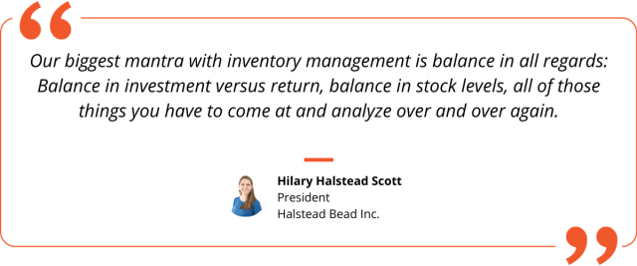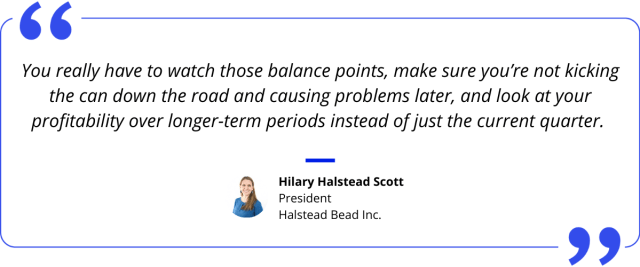Why Your Inventory Process Is Failing — and How to Fix It
Contents
It’s no secret that even established retailers and brands grapple with the complexities involved in ordering, storing, and otherwise handling their non-capitalized assets, better known as inventory management. That’s because it’s an art form that can take years to master, only to present new challenges as businesses evolve. The bottom line? There has to be just enough stock at any given time—not too little, not too much—and it’s far easier said than done.
That’s why we tapped Hilary Halstead Scott, president of jewelry wholesaler and distributor Halstead Bead, for her insights on the current state of ecommerce inventory management. With two decades of experience in this area, she’s learned a thing or two about why your current system is failing, how to streamline your processes, and the reason why continuing to improve is key to business longevity.
Why are continuously effective inventory management practices crucial for established brands and retailers?
Hilary Scott: [Inventory] directly hits your bottom line, so it’s critically important. It can really affect your cash flow and the overall profitability of the company, depending on how well you control your inventory and make sure you’re generating good returns on investment in that asset.

How does this make or break your business? Why should established businesses care about continuing to improve their inventory strategies?
Hilary Scott: It’s a matter of balance. A lot of companies focus on 100% order fulfillment and never missing a sale by stocking out on inventory, which can really lead to overstock and bloat your inventory levels quickly. That can be dangerous in the long run if it leads you to overstock and take on too much inventory that not only drains your cash flow, but can also cause problems if you carry a type of product that may go out of fashion, spoil, or somehow degrade over time. You end up writing off inventory later in order to capture a sale now.
You really have to watch those balance points, make sure you’re not kicking the can down the road and causing problems later, and look at your profitability over longer-term periods instead of just the current quarter. For brands wanting to sidestep inventory challenges entirely, newer models like print-on-demand or dropshipping let you sell online without inventory, freeing up cash flow and reducing risk.
What are the top 3 mistakes brands and retailers make when trying to manage their inventory?
Hilary Scott: Number one is definitely overstocking. It really requires discipline from your purchasing department to make sure they’re trying to match stock levels to demand as closely as possible without carrying too much excess. That’s a real factor.
Number two is speed of turnover. That depends a lot on the individual industry and whether you’re subject to commodity-based price changes or other market forces that can really change the value of your inventory holding, especially compared to your price points. Usually your costs for materials change at different rates than your prices to customers, so you can end up with a mismatch there if you’re not turning your inventory very quickly.

Number three is just getting it wrong by not following your data. A lot of people spend a lot of effort stocking the wrong products that really aren’t the ones driving revenue. You have to stratify your inventory in a way to understand which pieces of your collection are really driving your revenue and profitability, and you have to make sure you focus the most on those items. Not everything in your stock portfolio has the same value to the business overall, so you need to treat those different segments of your inventory differently.
Have you seen any notable trends in the last few years in inventory management?
Hilary Scott: Absolutely. Data and warehouse management solutions have really helped stocking vendors to better understand what drives inventory investment and return on investment in their businesses, so technology has definitely helped in those regards. More recently, the pandemic alerted stocking vendors to the dangers of “just in time” inventory. It comes down to a question of balance—you do want to avoid overstocking, but you don’t want to be so lean that you get caught out if there’s a supply chain disruption like we all just experienced in the last year or two. That was a good reminder that you can be too lean, depending too heavily on those rapid turns.
Our biggest mantra with inventory management is balance in all regards: Balance in investment versus return, balance in stock levels, all of those things you have to come at and analyze over and over again. Make sure you have a devil’s advocate in your space to keep your decisions in check and reassess your logic from time to time based on current conditions.
What else should businesses know?
Hilary Scott: It’s really important to make sure your purchasing department and accounting department are talking with one another regularly. A lot of times those are very different people in an organization, so they lose sight of inventory valuation and how it affects cash flow. Those two sides of your business really need to be talking regularly and monitoring inventory valuation to make sure all your business cash flow needs are being met and you’re making those solid balancing decisions together
President, Halstead Bead Inc.






